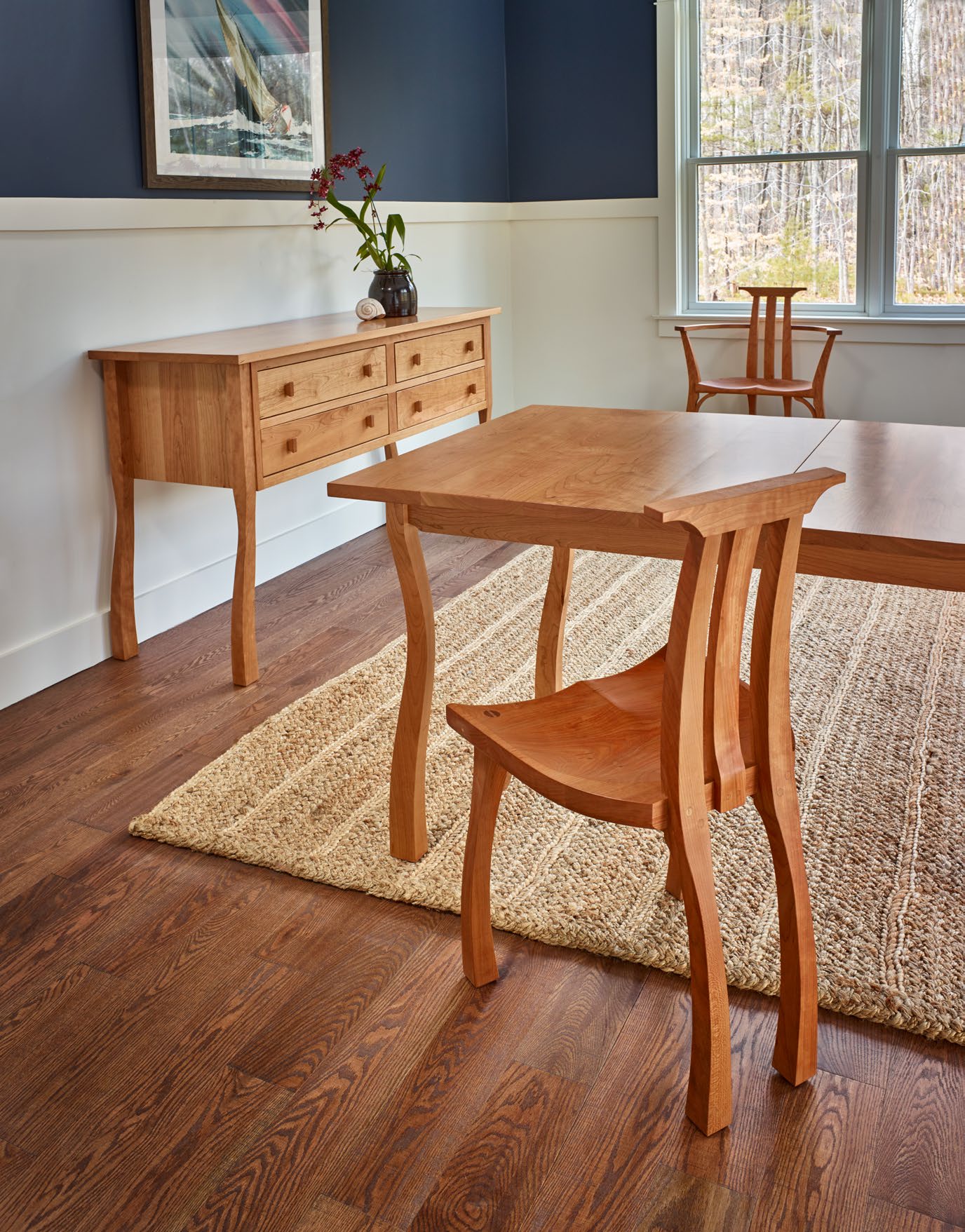Maine furniture company shifts to locally-sourced wood
By Lee Burnett
When Chilton Furniture changed hands four years ago, nearly three quarters of its furniture was being built in Indiana.
Today, more than half the furniture is made in Maine and the percentage keeps climbing.
“It was a very deliberate choice,” said co-owner Jennifer Levin of the decision to shift production to Maine. “In the past ten years, we’ve gotten to eat local, so why not do the same with furniture. It just made sense.”
Chilton Furniture originated as a 19th century paint company and was once well known for its unfinished pine furniture. More recently is has been known for its Shaker-inspired furniture designs. It has showrooms in Scarborough and in Freeport, just down the road from Thomas E Moser, the granddaddy of Maine furniture makers.
This made-in-Maine story is the work of transplants from Westchester County, NY who knew nothing about furniture building when they acquired the company and moved to Maine in 2014. Husband Jared is a portfolio manager. Jennifer is starting a second career after stints as a Wall Street lawyer and stay-at-home mom. Maine had been a vacation destination for them both; it was also where Jennifer had spent summers as a child (Ocean Park) and her college years (Bates). A business-for-sale ad caught their eye and before long they were the owners of a venerable Maine business.
“I knew nothing. Nothing. Other than liking furniture and being a bit compulsive,” she said. Levin is animated. As she tells stories about her favorite furniture makers, she moves from room to room in Chilton’s Freeport showroom touching beds, chairs and tables.
The “clean, minimalist” look of Shaker Furniture appealed to Jen. She started reading furniture books and meeting furniture builders. She learned the names of different kinds of joinery. She attended a trade show in Indiana, the heart of Amish furniture manufacturing and source of much of Chilton’s furniture.
“I’m learning as I go,” she said, admitting the steep learning curve she faces. “CAD drawing, woodworking, and engineering - those are three basic [furniture design] skills I do not have. I have the aesthetic, the vision.”
The Levins also have a name to build on. Today, Shaker furniture is so popular, it’s practically a cliché, but Chilton has a decent claim on authenticity. Chilton Furniture and Tappan Chairs in Center Sandwich, NH have developed an exclusive arrangement to produce furniture for United Society of Shakers, the last remaining Shaker community in New Gloucester. The Levins have become friends with Michael Graham, director at Sabathday Lake, Brother Arnold and others. The friendship and history buoys Jen whenever she gets discouraged by the learning curve of a new business.
“I never lost sight that we had a name,” said Jen.
Sourcing more furniture from Maine developed as a result of Jennifer’s growing interest in design. Her enthusiasm includes Scandinavian, Japanese, mid-century modern, painted, even some Mission designs. But she quickly learned that she had little design influence if her preferences were out of sync with Amish furniture manufacturers, a network of purveyors she calls “a juggernaut.”
She found Maine furniture makers more receptive. “Maine builders are a little more humble,” she said. “They’ll tell me ‘if you want to try it, I’ll try it.’” She believes the quality is higher and she values the relationships she is developing with small furniture makers all over the state. “I wanted to be able to come to their shops and talk, get to know the builders and feel like they understood me,” she said.
“I like that they are local. I feel working with them helps our community, and therefore there is more work, more opportunity and it’s better for everyone.”
It would be comforting if Maine-made furniture were also Maine-grown wood. But that may be wishful thinking, given the complicated supply chains involved. One example may illustrate. One of
Chilton’s furniture makers is Peter Brown, owner of Meadowlark Designs in Lyman. With a strong interest in sustainability, Brown uses plant-based finishes and buys furniture stock locally from Seacoast Hardwood in Sanford.
“The closer to home the better,” he said.
But Brown knows that wholesale hardwood lumber comes from all over the US, even the world.
“I don’t think there’s a good defensible source trail to guarantee a piece of wood comes from anywhere,” said Brown. The exception is wood certified as sustainably grown by third-party audits, such as the Forest Stewardship Council.
So Brown does the best he can by forsaking tropical hardwoods and limiting himself to wood that travels short distances, such as maple, oak, cherry, some walnut.
“I contain myself to temperate hardwoods,” he said. “If you’re buying maple, a certain percentage of that is coming from Maine,” he said.
Brown says he appreciates Chilton’s new direction.
“I see what they’re doing. I think it’s a great direction,” he says. “There are a lot of very, very good craftspeople in Maine. Locally made is important to people.”


